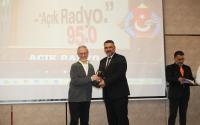Published on Friday, April 15, 2005 by the Inter Press ServiceZoltán Dujisin
Almost 20 years have passed since the world's worst nuclear accident, but Chernobyl continues to bring back traumatizing memories for many Ukrainians.
The disaster continues to account for deaths and illnesses, but this has not stopped a few determined residents from coming back to contaminated areas to reclaim their old everyday life.
On April 26, 1986, an explosion occurred in reactor 4 of the Chernobyl Nuclear Plant in northern Ukraine. A fire broke out and huge quantities of radioactive debris were released. The authorities were first preoccupied with controlling the fire, and neglected the surrounding population that was left for four days without any information on the catastrophe.
After the government admitted the disaster, close to 150,000 inhabitants from nearby cities and villages were evacuated. People in Pripiat, the largest city in the region, left under the impression that they would return shortly.
They never did. Today the town that once hosted 47,000 citizens is a ghostly space of empty buildings and roads invaded by advancing flora.
The houses, libraries, schools, and sports and recreational centers in what was a model of socialist urbanization built in the seventies, have since the disaster seen only looters, scientists, and a few adventurous tourists.
Entering the local school presents the visitor with a spine-chilling scenery of desks, open books, rotten pianos and gas masks scattered over a floor that looks ready to give in. This school, like the buildings surrounding it, has remained untouched for almost two decades.
Most of Pripiat's residents were involved with the nuclear plant one way or another. Their misfortune was to live only a kilometer away from it.
While Pripiat will never see life again, further away from the plant, still within the radius of a 30km government-restricted zone, villagers have been reoccupying their abandoned homes in an illegal move to which the state turns a blind eye.
The villages are not a rousing tale either. Seemingly abandoned, the sudden sight of a pensioner eventually says otherwise. The average age of its inhabitants is 68, they live mostly in solitude, surrounded by stranded households, and under harsh material conditions. They are relatively indifferent to radiation-related risks.
"Some specialists feel mass resettlement was a mistake," Evhen Golovakha, deputy director of the Institute of Sociology of the Academy of Sciences of Ukraine told IPS. "People who live in their own villages and towns feel better than those resettled."
Yuri Privalov, director of the Center of Social Expertise said it was not easy to settle in new conditions. "Adaptation to a community with differences in culture and language is not easy," he told IPS.
But Privalov does not dismiss the economic aspect. "They lost everything, the government couldn't find everyone a new job, and was unable to cover all their expenses."
If Pripiat and surroundings present a post-apocalyptic scenario, the Chernobyl power plant is its complete opposite.
The plant is abuzz with activity. Scientists, engineers and workmen wander the installation wearing simple uniforms, apparently indifferent to possible radioactive threats. One concern they have is that the complete closure of the plant, which they opposed, will be at the expense of their above-average salaries.
Following acute international pressure, the Ukrainian government closed the last working reactor in 2000. The plant's activities revolve these days around maintenance of the concrete 'sarcophagus' that covers the ruins of the explosion.
While radiation levels are not excessive at present, the precariousness of the structure has compelled the government to approve construction of a new safe confinement surmounting the old concrete block.
The project has already kicked off, but "the overall cost of the task is 1 billion, 91 million dollars," Igor Vasilevich from the Ministry of Fuel and Energy told IPS. "We had donations from several developed countries, but it's far from enough."
In line with dominant international interests, most current government efforts are directed at increasing nuclear safety levels. But there is also a costly social dimension to Chernobyl.
Ukraine had to outgrow two separate Chernobyl traumas: the first following the explosion, the second when mass media gave a true account of its consequences. It is estimated that around six million people have been affected in some manner. Even a close estimate of the number of deaths will probably never be reached.
Up to 50 were reported dead as a result of immediate exposure. Other estimates range from 250 to a few thousand.
But many continue to face grave health problems. The most dramatic is the situation of the so-called "children of Chernobyl" who grew up in contaminated areas and now suffer from thyroid cancer.
Many more people have had to deal with psychological problems. A report by the Democratic Initiatives Center that assessed the situation 10 years after the disaster says that among those affected, 60 percent "associated food products with fear, and experience helplessness, insomnia and irritability", while 30 percent "lost their interest in life."
For these victims, the disaster meant the "ruin of their world views, lifestyles and plans," the report says. Most resettlers overcame a general disenchantment and helplessness with time, but many others have been left behind.
Yuri Privalov concedes that victims need further assistance, but also that not much more could be done. "It's hard to say what's sufficient, since we have no similar situation to compare with. There are many demands on the state, with ill people, the plant's deactivation, and the earth's pollution. The country is quite poor, of course problems will remain."
http://www.commondreams.org/cgi-bin/print.cgi?file=/headlines05/0415-05.htm






